If you want to plant spectacular perennials in your garden that will make a statement with their beautiful blooms, buttercups, also called ranunculus, is an excellent choice.
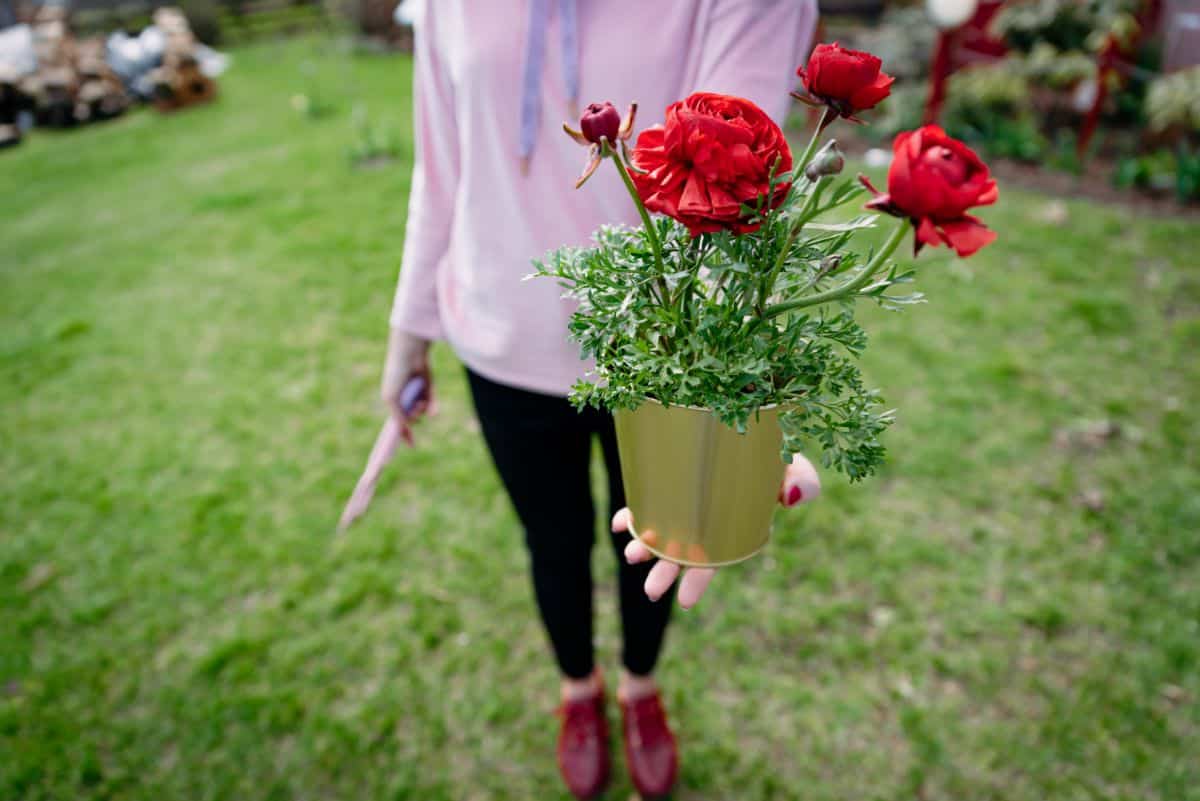
In this article, we will help you get started growing buttercups in your own garden. Jump directly to the section you need in the advanced jump below, or read on for our full ranunculus growing guide.
Jump to:
- What Are Buttercups?
- Buttercup Basics
- Where Do Buttercups Grow?
- Why Grow Ranunculus?
- Buttercup Landscaping Ideas
- Recommended Ranunculus Varieties
- When Do Ranunculus Bloom?
- How Long Do Buttercups Bloom?
- When to Plant Buttercups
- Ideal Growing Conditions for Ranunculus
- How to Plant Ranunculus
- How to Propagate Ranunculus
- How to Care for Buttercups
- Recommended Planting Combinations for Ranunculus
- Frequently Asked Questions About Growing Buttercups
- Where to Buy Buttercups
What Are Buttercups?
Buttercups are plants that belong to the genus Ranunculus of the family Ranunculaceae. In all, it contains over 1,800 species.
These plants are called “buttercups” or “ranunculus” interchangeably. A couple of less common names that also refer to plants in this genus include water crowfoots and spearworts.
You will find a lot of diversity in the Ranunculus genus. Some of the flowers in this genus have a fairly modest appearance, like the classic Ranunculus repens creeping buttercup, which produces small yellow flowers.
Others produce large, showy, colorful blooms that look completely different (more like roses or large poppies) and which have become extremely popular as ornamental and cut flowers.
Buttercup Basics
| Zones: | 8-10 |
| Blooming season: | Spring |
| Expected height: | Up to 18 inches |
| Soil: | Well-draining soil |
| Sun: | Full to partial |
Where Do Buttercups Grow?
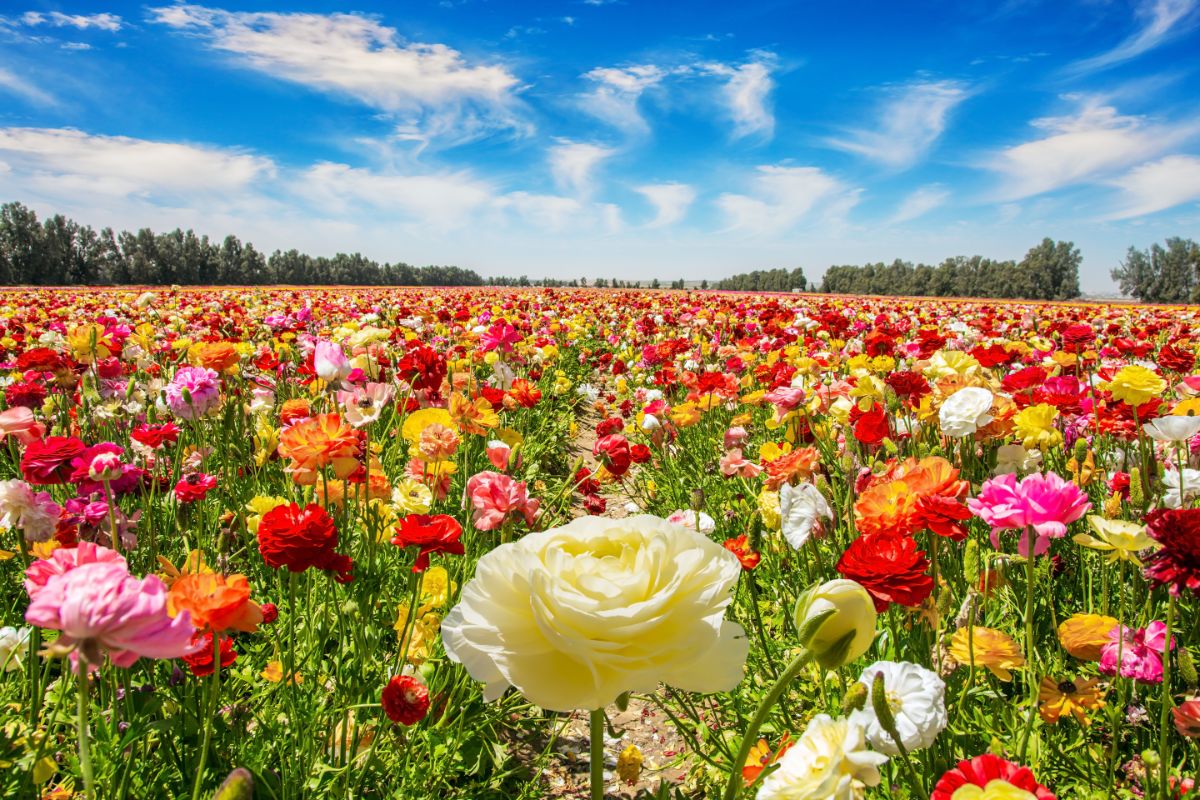
Ranunculus plants are native to Southwest Asia and made their way to Europe during the 16th century. Since then, they have been cultivated worldwide.
Why Grow Ranunculus?
Here are some top reasons to grow beautiful buttercups in your garden:
• Ranunculus makes gorgeous cut flowers that can last up to 10 days if you cut them early enough.
• The pollinators in your area will love your buttercups, especially hummingbirds.
• These are cost-effective bulb plants. That is not the case with a lot of other bulbs. Even gardeners on a tight budget can afford buttercup flowers.
• Growing and maintaining ranunculus plants is super easy.
• Ranunculus comes in so many different colors. You can find white flowers, red flowers, orange flowers, pink flowers, yellow flowers, and purple flowers.
• Propagation is fast and efficient, especially by division. You will be surprised by just how quickly the corms can multiply.
• Winter foliage may be a feature in some cases, depending on your climate zone, the type of ranunculus, and when you plant it.
Buttercup Landscaping Ideas
The small yellow buttercups you might sometimes picture when you think of plants in this genus tend to fill up whole fields and meadows. Unless these grow naturally on your property, you probably will not plant them since they spread so aggressively.
The larger ornamental buttercups, on the other hand, make excellent border flowers. They also look great in containers on your deck or patio.
Since buttercups can do well in sandy soils, they also sometimes can work in your rock gardens.
Recommended Ranunculus Varieties
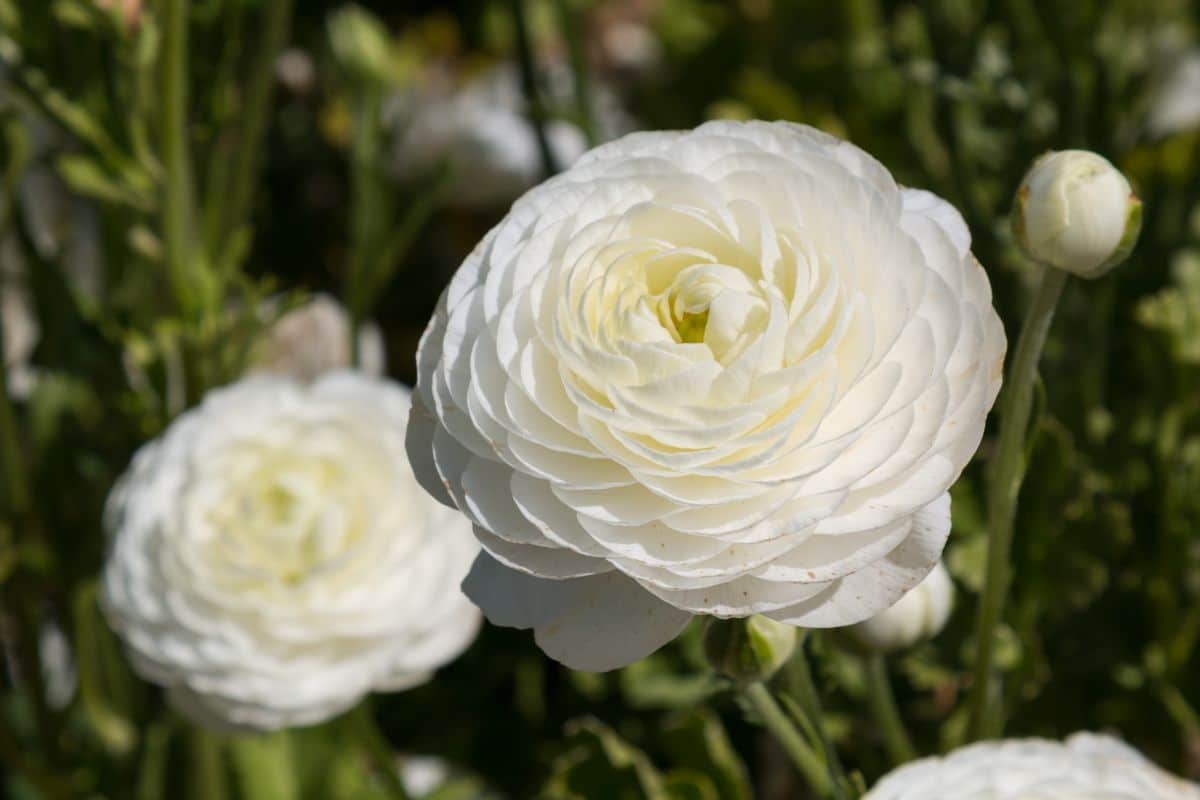
Here are some popular cultivars of these beautiful flowers you might want to plant in your perennial garden:
• Cloni Dark Orange: This buttercup variety boasts spectacular blooms with a deep orange color that looks a lot like roses.
• Pon Pon Malva: This Persian buttercup features large, fluffy, dramatic blooms that are greenish in the middle and purplish-pinkish around the edges.
• Mache Purple: If you want a deep purple flower color, consider this exquisite rose-like cultivar.
• Purple Picotee: One of the most dramatic types of buttercups you will find is this one. The appearance is rose-like, with white petals that are rimmed with dark purple for a spectacular contrast. You can also find Pink Picotee blooms for a slightly different look.
• Tomer Yellow: This type of ranunculus features a golden yellow hue that is so deep and vivid that it is almost orangey.
• Amandine Pastel Lemon: It would be very easy to mistake these ranunculus flowers for actual roses. The blooms feature a combination of yellow and peachy hues. They tolerate warm weather better than the average buttercup, which means they may stay in bloom longer than some of the others in your garden. You will discover this is true of others in the Amandine series as well.
• Amandine Tiger: These showy flowers have a creamy color with dark pink around their ruffled edges.
• Amandine White: Been looking for the perfect white buttercup? You cannot go wrong with Amandine White.
• Amandine Bonbon: If you want to plant buttercups in your garden that have a vivid hot pink color, you will adore the eye-catching Amandine Bonbon cultivar.
• Amandine Black: While most cultivars of buttercups feature medium or light hues, there are some notable exceptions. Among them is the Amandine Black cultivar, which sports petals in a deep burgundy hue that may appear nearly black in certain lighting.
• Amandine Scarlatto: For red flowers, you will want to consider this striking cultivar with its vivid hue. Hummingbirds are going to love this one!
• Tangerine Orange: These blooms not only are the same bright, juicy orange color as your favorite citrus fruits, but they even look as round as tangerines!
• Chartreuse: The bold yellowish-greenish hue of this type of buttercup is incredibly unique.
• Butterfly Artemis: If you want a different look altogether, think about this cultivar. It features more modest yellow blooms with dark centers that are similar in appearance to creeping buttercups.
• Butterfly Europe: The shape of this cultivar is similar to that of Artemis, but the petals are a light purplish-brownish color instead.
• Butterfly Hades: As you might guess, this cultivar also looks similar to the two above. But the petals are fiery orange.
• Romance Libros: The fluffy golden blooms of the Romance Libros cultivar of buttercup will put you in mind of marigolds.
• Reinette Blond: Here are some unusual buttercups. Their blooms come in hues of pink, yellow, and peach, but in the center of each flower are some green petals.
• Reinette Rose: This cultivar is similar to Reinette Blond, except that the flowers are all pink with green centers.
• Half-Clone Iceberg: These white ranunculus flowers will amaze you with their densely packed petals and perfect rose-like shapes. They have a romantic vibe and would look gorgeous in a bride’s bouquet.
• Purple Jean: Here is a cultivar of buttercup that produces flowers with a bright pinkish-purple hue.
• Butterfly Thiva: Like the other buttercups in the Butterfly series, this cultivar features simple blooms with an open appearance, rather than the densely-packed rose-like blooms of other cultivars. The petals are pale purple/white with darker purple toward the yellow centers.
• Poodle Ramlia: Each of these flowers has the look of a fluffy bright pink pompon.
• Romance Salerno: This majestic cultivar of ranunculus features massive blooms with a warm peachy hue.
• Romance Odon: Another cultivar to think about getting if you want darker flower colors is Odon. The large blossoms are a deep red color with green in the center.
• Reinette Cream: If you want a super vivid contrast, then look no further than the Reinette Cream cultivar. The flowers feature green petals in the center and white outer petals.
• Amandine Antique Yellow: Enjoy these sunny yellow buttercup blooms with hints of peach and orange.
The above is truly just a small sample of the exquisite variety of ranunculus cultivars that are out there.
When Do Ranunculus Bloom?

Buttercups are classic spring flowers, blooming in the early- to mid-season. Some ranunculus plants might also continue blooming into the early part of summer.
How Long Do Buttercups Bloom?
A bloom time of around 6 to 7 weeks means you can get plenty of enjoyment out of your ranunculus plants each year.
When to Plant Buttercups
The best time for planting these flowers depends on your climate zone. In areas where buttercups are hardy, you should plant them in the fall.
But if you live in a zone where buttercups are not hardy, then you need to be concerned about frosts. You should wait for late winter or even early spring.
Ideal Growing Conditions for Ranunculus
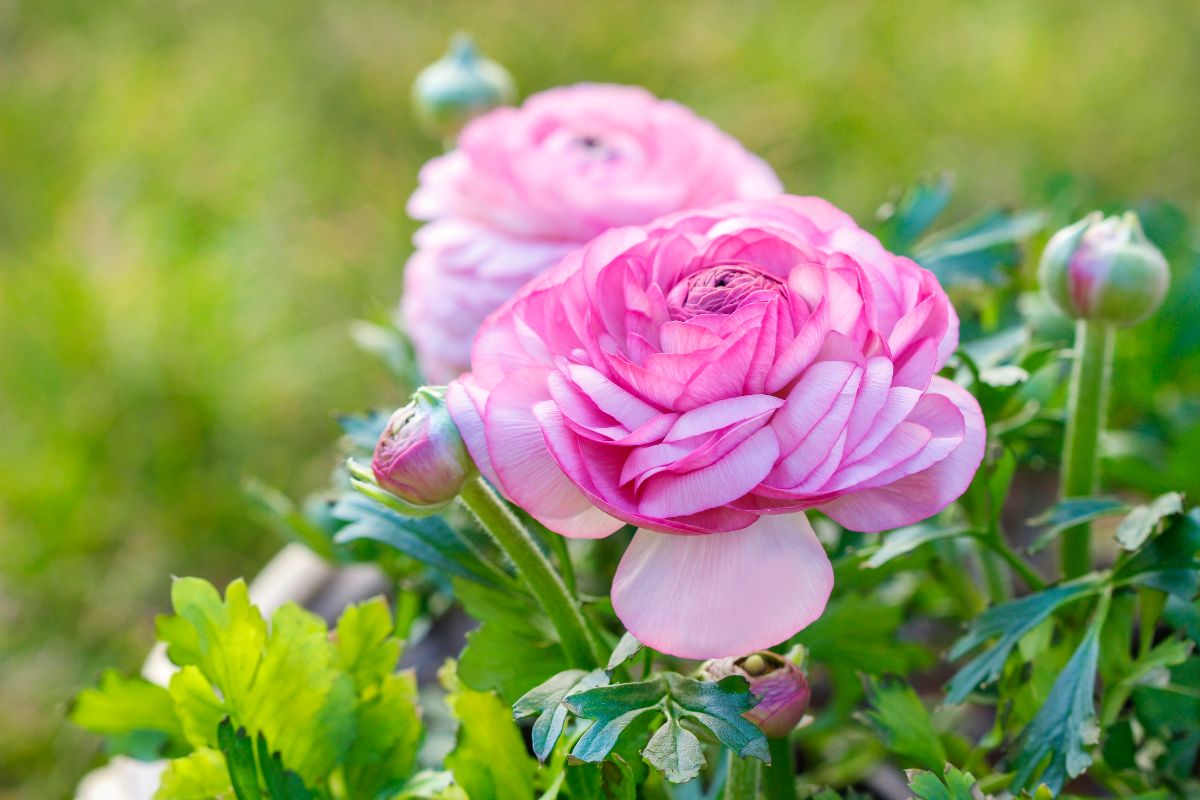
What are the sun, soil, and water requirements for growing buttercups successfully? Let’s go over each so you can find the perfect spot in your garden for these showy flowers.
How Much Sun Do Buttercups Need?
Full or partial sunlight is best for a ranunculus. If you are growing them in a warm climate, afternoon shade may be helpful. But if you are growing them in a cool climate, they may be happier getting full direct sunlight all day.

What Type of Soil is Right for Buttercups?
Moist, well-drained soil is best for a ranunculus. They will be happy in loamy soil but may struggle in heavy soil like clay. They prefer rich soil to poor soil, so plan on amending yours if necessary.
Buttercups are flexible when it comes to pH. Whether your soil is neutral, mildly acidic, or mildly alkaline, they should grow just fine.
How Much Water Do Buttercups Need?
Consistent water is important for buttercups, but it is critical that they do not get wet feet, as rot can set in easily.
The best way to ensure the right water content is to push a finger into the soil to check whether the top 1-2 inches are dry yet.
If they are, then it is time to water. But if they are still moist, then you need to wait. When it does come time to water, do so deeply.
Depending on what the weather is like where you live, rainfall may sometimes take care of this job on your behalf.
How to Plant Ranunculus
You can grow ranunculus flowers in pots or in your garden beds. Below, we offer step-by-step planting instructions.
Ground Planting
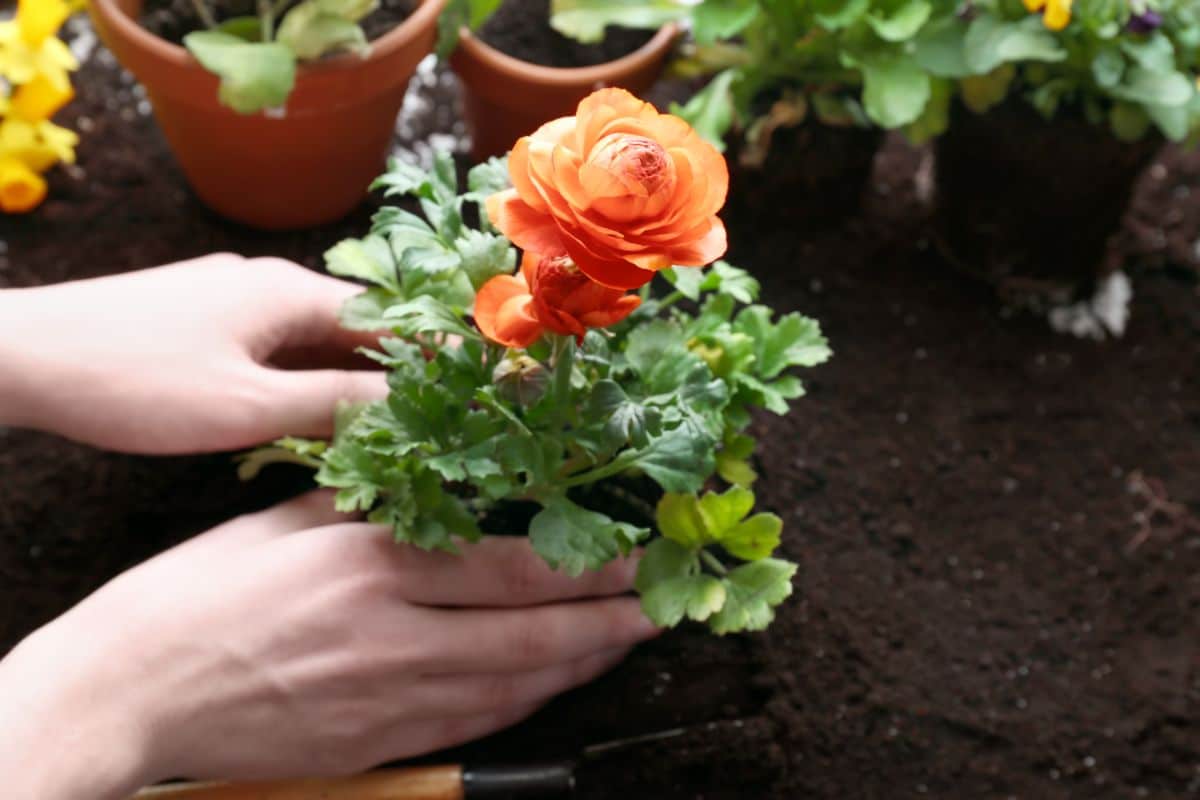
1. Choose a spot in your garden and prepare your soil. Try mixing in peat moss or compost to provide the rich environment your ranunculus plants will need to grow their best.
2. Dig holes for your ranunculus bulbs. Space apart plants 4-6”.
6. Backfill the soil around the bulbs. They should be around 2-3” deep.
7. Water well after planting.
Container Planting
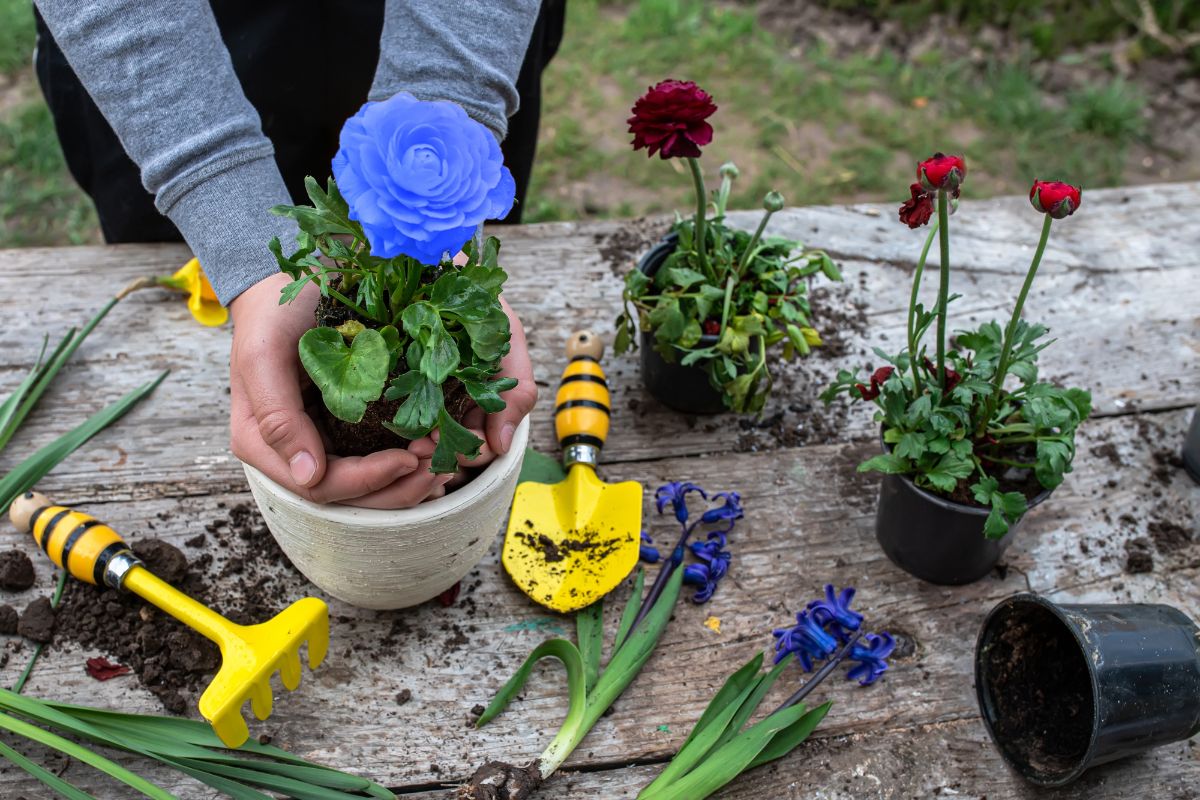
1. To grow buttercups in containers, choose pots with drainage holes and fill them with potting soil.
2. Insert the bulbs and finish filling in the potting mix around them. You should be able to get a pair or trio of tubers to fit in a 10” pot if they are small. If you have jumbo tubers, only one will fit in a container this size.
3. Water your new container plants well.
After you finish planting ranunculus tubers and do that initial watering, you should wait to water them again until you see them sprouting up above the soil. If you try to water them again too soon, they may rot.
How to Propagate Ranunculus
If you have some buttercups already growing in your garden and you want to propagate them, you can do so easily enough.
You can either harvest ranunculus seeds or you can divide your plants.
Some types of buttercups also spread pretty much effortlessly on their own (indeed, if anything, you might need to make efforts to contain them).
If you do want to propagate ranunculus either by seed or by division, you can follow the steps below.
Starting Buttercups from Seed
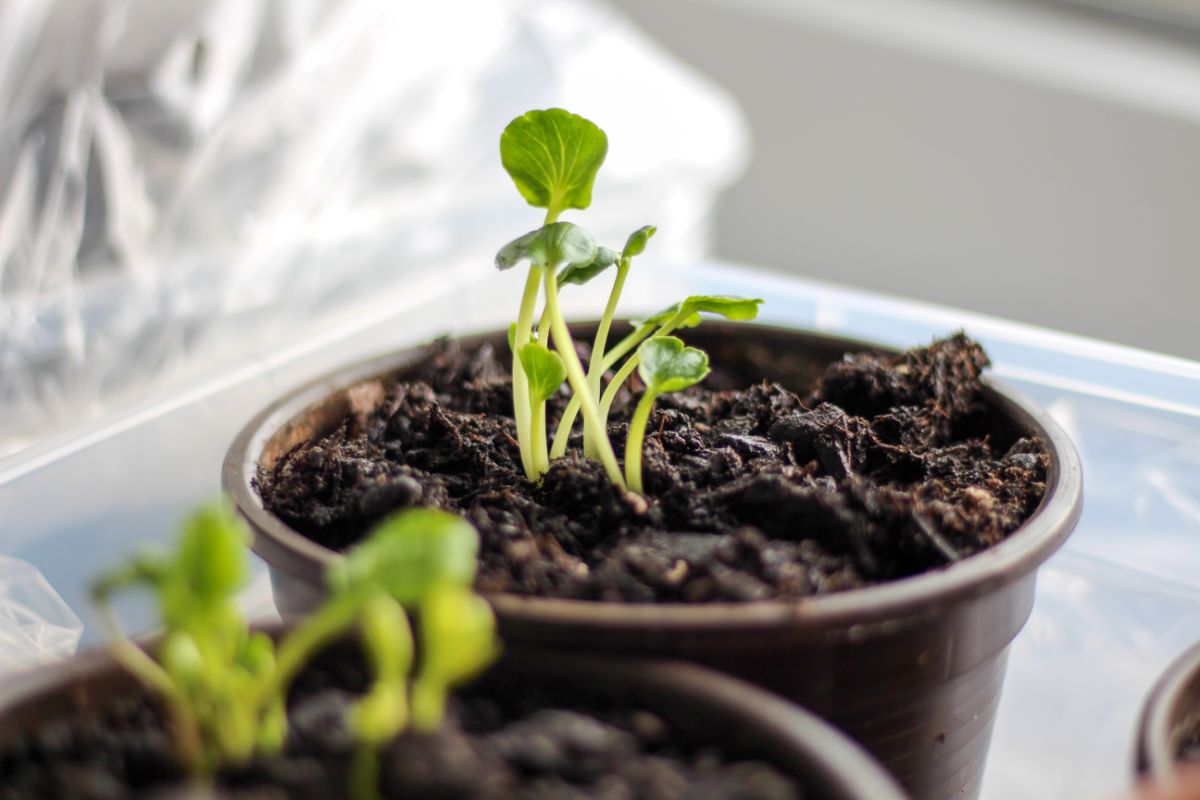
1. First, you either need to purchase seeds or collect them. If you have your own buttercup plants, wait for the flowers to wilt so the plants will go to seed.
Grab a paper bag, and hold it above one of the seed heads. Then, run your hand over it. The seeds will fall right out.
Your job isn’t done, however, because the seeds are each inside little flakes. A lot of the little flakes you collected will not contain seeds. So, you need to go through your pile and separate out the ones that don’t (you can see right through them, so you will be able to tell with a simple visual inspection which ones have seeds).
Once you have discarded the empty flakes, you can store the flakes with seeds in a cool, dry location until you are ready to germinate them.
2. Get some trays with drainage holes and fill them with seed starting mix.
3. Sow the seeds. You should push each one into the starting mix a little bit.
4. Find a spot where the temperatures range between 50 and 60 degrees Fahrenheit where your seeds can germinate. Make sure they are not getting direct sunlight.
5. Keep the starter mix moist while the seeds are germinating.
6. When the seedlings sprout, continue to maintain the moisture of the starter mix. Eventually, they will develop 4-5 true leaves.
7. At this point, your seedlings will need more space, so you will have to transfer them to a larger container.
8. When you are ready to move the new ranunculus plants outside, you will need to harden them first. Take them outside for brief periods of time, then for longer and longer periods of time. This process gets them used to the outdoors before you make the change permanent.
9. Plant the hardened young buttercups outside.
How to Divide Buttercups
1. Use a trowel to dig in a circle around the plant you want to divide. When you have finished cutting the circle, push down underneath the plant, and pry it up from the ground.
2. Wipe away the loose dirt and debris.
3. Now, you may want to store them somewhere cool and dry for about a week to let them air out. Doing this will release the moisture from them, so they are less brittle.
Note: Is your climate super dry? You might want to just wait a day or two before proceeding rather than a week.
Ironically, they can get to be way too brittle again if they dry out too much. So, it is really a question of finding balance.
4. Perform the division. Assuming you achieved an ideal moisture level, you should be able to get a clean break without unwanted damage.
5. Plant the newly divided ranunculus plants.
How to Care for Buttercups
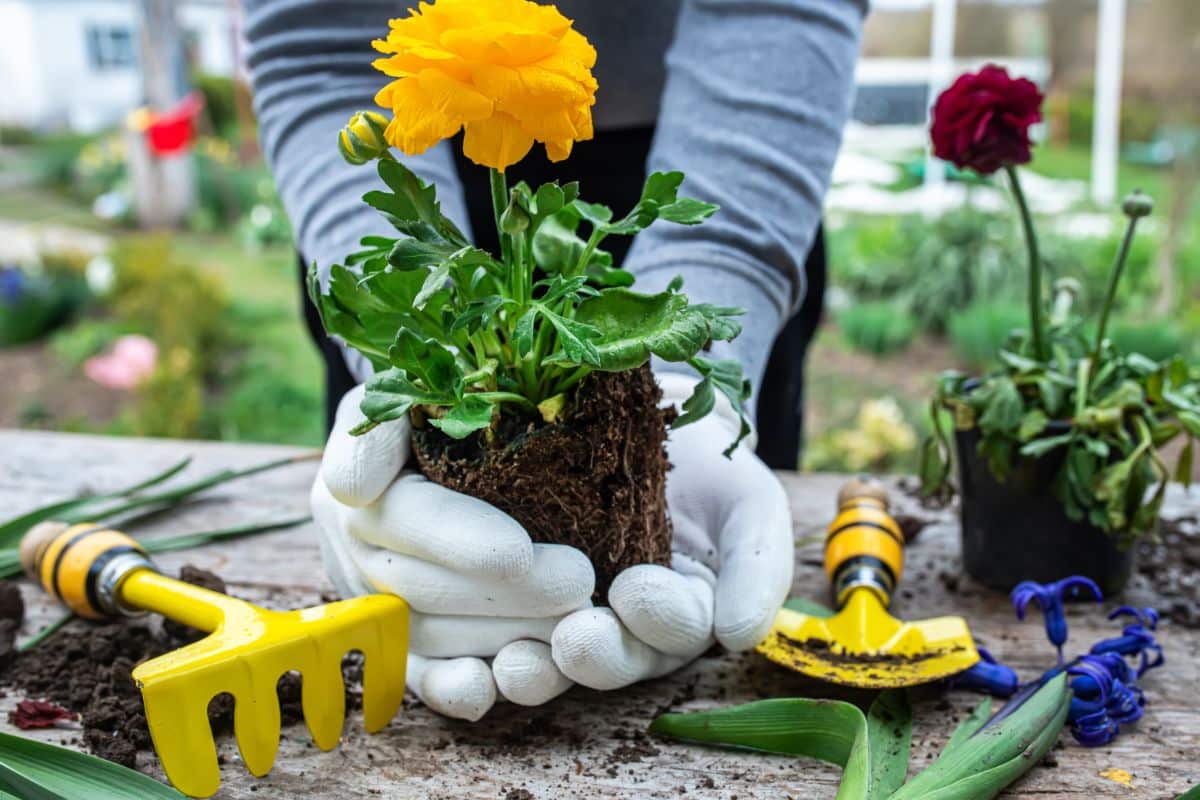
You are ready to plant and propagate ranunculus plants now. But how do you maintain them? Let’s go over what you need to know about fertilizing, mulching, staking, pruning, and overwintering buttercups.
How to Fertilize Buttercups
Ranunculus appreciates fertilizer. You should do your first round 6-8 weeks after you plant your buttercups. Go with a granular formula.
The next fertilizer round should come a month after that, but you should switch from a granular product to a liquid one that you can dilute.
You can continue to fertilize monthly during the remainder of the growing season. Correct utilization of fertilizer will help ensure the abundant look you want in your garden.
Keep in mind that what “correct” means may vary depending on the specific type of buttercup you have and your climate and soil conditions.
We see some sources that recommend fertilizing as often as twice monthly.
So, it may require some trial and error for you to optimize the feeding schedule for your own ranunculus plants.
How to Mulch Buttercups
Ranunculus plants love cool spring weather, and they need moist soil to flourish. So, it is a great idea to mulch them.
That way, the moisture retention in the soil will improve, plus the insulating effect of the mulch will prevent the soil from heating up too quickly as you head into late spring.
That means your buttercups may bloom longer than they would otherwise.
How to Stake Buttercups
Most of the time, ranunculus plants grow upright on their own without needing to be staked.
The exception is in climates where the weather gets very hot. If you are noticing your plants drooping in these conditions, you might want to use twine to tie them to some garden stakes.
If you already know in advance before planting that you are going to be dealing with conditions like these, you might consider planting the buttercups, where they will get a little afternoon shade.
On a related note, if you are cutting ranunculus flowers for a floral arrangement, be mindful of the stems. As they are hollow, they are easy to break or crush. Take care when transporting them.
How to Prune Buttercups
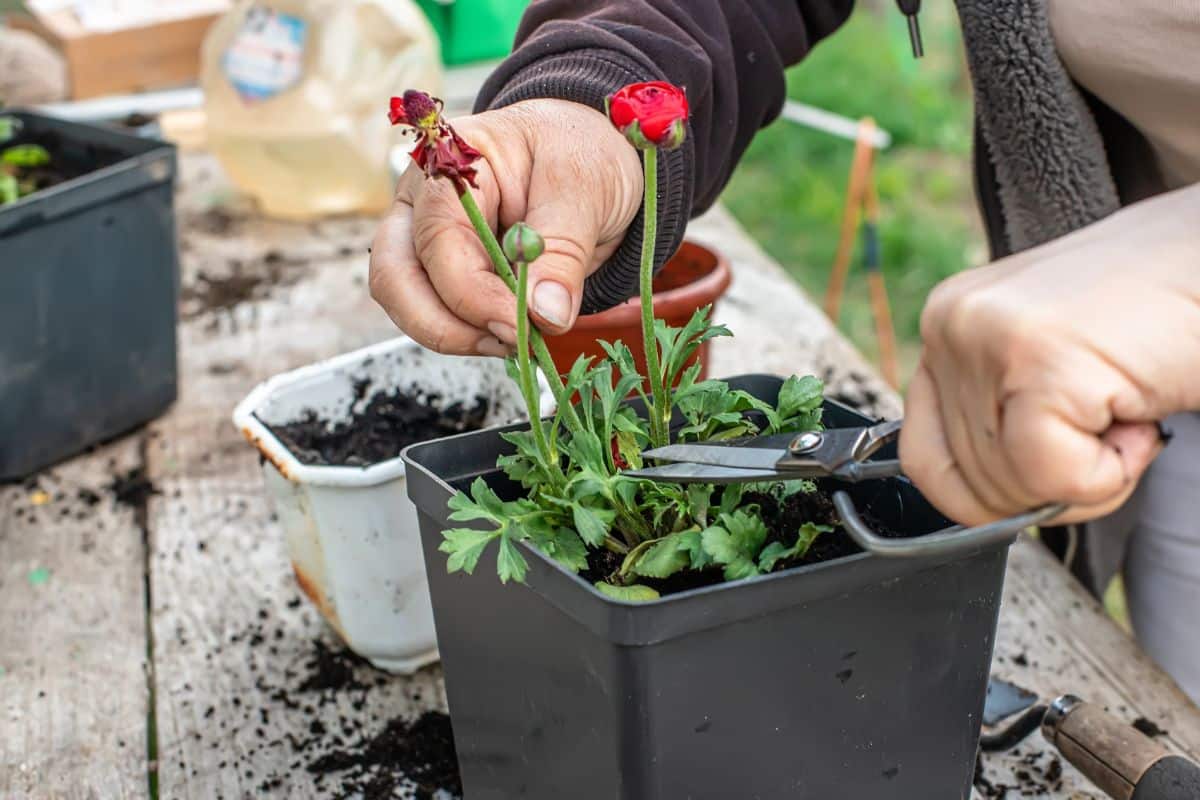
Ranunculus plants are not too demanding in the pruning department; they just need deadheading during the bloom season, followed by cutting back at the end of the season.
How to Deadhead Buttercups
Unless you want your buttercups to go to seed, it is a good idea to deadhead them. Doing so will help your plants to produce blooms for longer.
Plus, some types of buttercups spread aggressively, so deadheading them may help you to keep their growth contained.
When to Cut Back Buttercups
At the end of the season, the leaves of the buttercups will yellow. Once they do, you can cease watering for the remainder of the year, as the plant is going dormant.
Cut the plant back, and decide whether to overwinter it (see below).
How to Overwinter Ranunculus
In climate zones where ranunculus is not hardy, leaving the corms out in your garden may cause them to die.
So you can continue enjoying them next year, dig them up and store them indoors to save them from the conditions of your harsh winters. A cool, dry location with plenty of air circulation is suitable. You might also want to apply a fungicide solution for extra protection.
One more option is simply to keep ranunculus as a houseplant. It can live indoors year-round.
Are Buttercups Vulnerable to Diseases or Pests?

Ranunculus may be affected by diseases such as powdery mildew, botrytis leaf spot, impatiens necrotic spot, erwinia blight, xanthomonas leaf spot, and pythium root rot. On this page, you can find a little more information on all of these.
Many diseases that afflict buttercups come about because the plants did not have sufficient drainage or adequate airflow. You can prevent those problems simply by planting them in suitable soil and spacing them apart at the appropriate distance.
As for pests, ranunculus may sometimes be infested with aphids, grubs, spider mites, thrips, and mealybugs.
Alas, the cool, moist climates that are ideal for buttercups also tend to be ideal for slugs and snails, which may cause additional problems.
Happily, deer and rabbits will generally avoid trying to eat buttercups. But you may have an additional problem in the form of birds.
Birds like to eat the shoots when they first come up. That means they can attack your ranunculus plants when they are vulnerable at the start of the season, interrupting new growth.
If you notice this is a problem, you will need to provide your plants with temporary protection from feathered visitors. A bit of netting should be sufficient in most cases.
When the shoots are half a foot tall, they are no longer as tender, which means birds lose interest in them. At that point, you can remove the netting, allowing the plant to grow freely, producing abundant foliage and blooms.
Recommended Planting Combinations for Ranunculus
Ranunculus is popularly recommended as a companion plant for quite a few other perennials and annuals, including:
• Freesias: These sweet-smelling blooms are hardy in zones 9-10 and like well-drained, fertile soil and full to partial sunlight. As such, they are ideal companions for a ranunculus. The different textures of freesia and ranunculus blooms provide contrast, while the wide range of colors available gives you countless options for creating exactly the look you desire in your garden. Freesias make excellent cut flowers as well, so if you plant them side by side, you will find it easy to gather blooms from both for your arrangements.
• Pansies: Like buttercups, pansies are happiest when temperatures are cool, which makes them suitable for companion planting with your ranunculus.
• Primroses: If you are growing your ranunculus in partial sun, consider planting some primroses alongside it. These plants require plenty of moisture and love cooler temperatures, just as ranunculus do.
• Larkspurs: The same light, well-draining soil that is good for ranunculus is also great for larkspurs. These plants like full sun, so they are the perfect companion for buttercups, you are planting in sunny conditions.
Frequently Asked Questions About Growing Buttercups
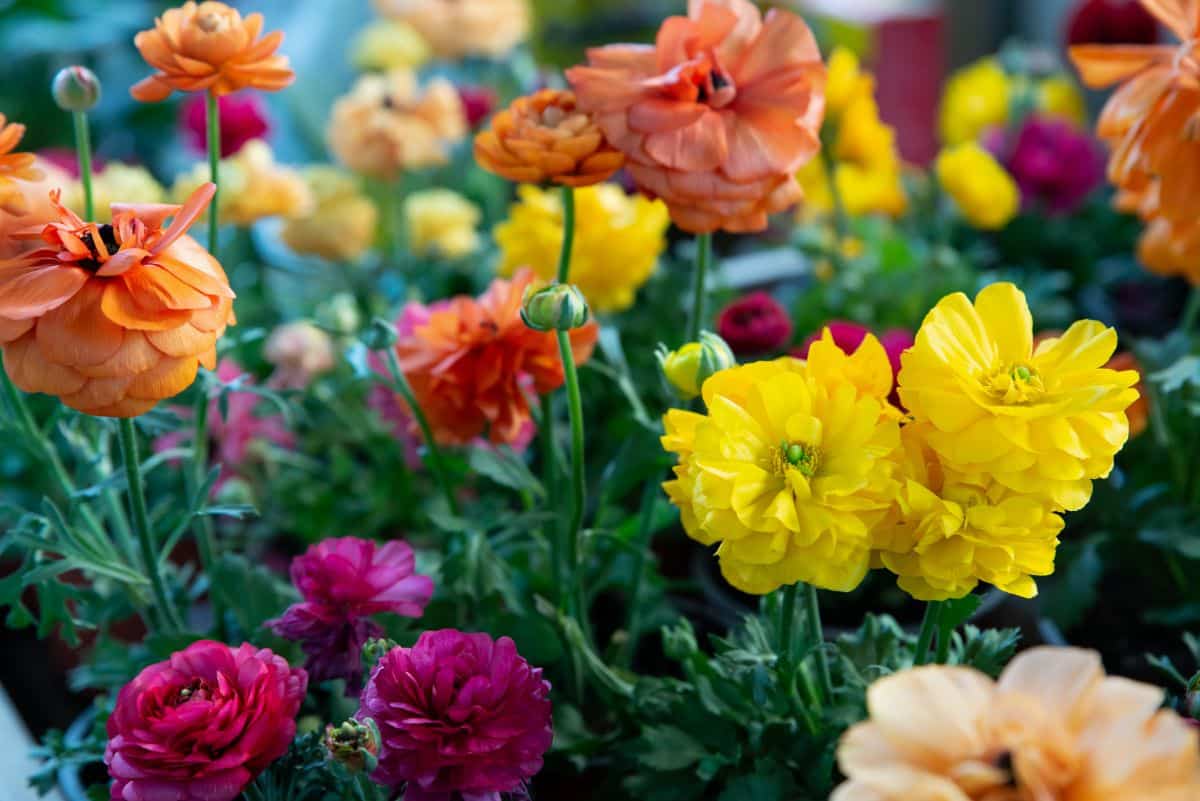
Mammals generally avoid eating buttercups. So, if something is chewing on yours, insects, slugs, snails, and birds are all good guesses. See the section on pests above for more information.
That depends on what type of buttercups we are talking about, as well as your location.
Creeping buttercup is considered to be an invasive weed in many parts of the world. Not only does the stuff spread like crazy, but it is toxic for pets and livestock (see below).
That said, there are cultivars of ranunculus that are non-invasive and which are ideal for your ornamental flower garden.
Research the type of buttercup you are considering for your garden, and check invasive species lists for your area to see if what you are choosing will be a good fit.
Yes, buttercup is toxic to horses, dogs, cats, cattle, and other animals. It is poisonous to humans as well.
If you or one of your family members or pets eats ranunculus, symptoms may include mouth blisters, salivation, diarrhea, and colic. If one of your pets consumes buttercup, you should contact your vet right away.
The fortunate thing is that usually, pets stay out of ranunculus. The reason is that the plant does not taste good, plus the mouth blisters can form rapidly. As a result, most animals are wise enough to avoid them.
Still, you should keep a careful eye on your pet while they are outdoors near your ranunculus plants.
While we are on this subject, some people experience skin irritations when they are handling buttercups.
So, if you are cutting flowers for your arrangements or maintaining your ranunculus plants, you may wish to wear gloves.
The majority of buttercup plants are classified as perennials. That means they can flower every year. There are some ranunculus plants that are also considered to be annuals or biennials.
Note that classifications depend in part upon where you live. A ranunculus that is hardy in zone 8 and up may be sold as a perennial in those zones but as an annual in cooler climate zones.
Thankfully, even in those cooler zones, you can get ranunculus to make it through the winter. See the section “How to Overwinter Ranunculus” for details on keeping this plant as a perennial no matter where you live.
Where to Buy Buttercups
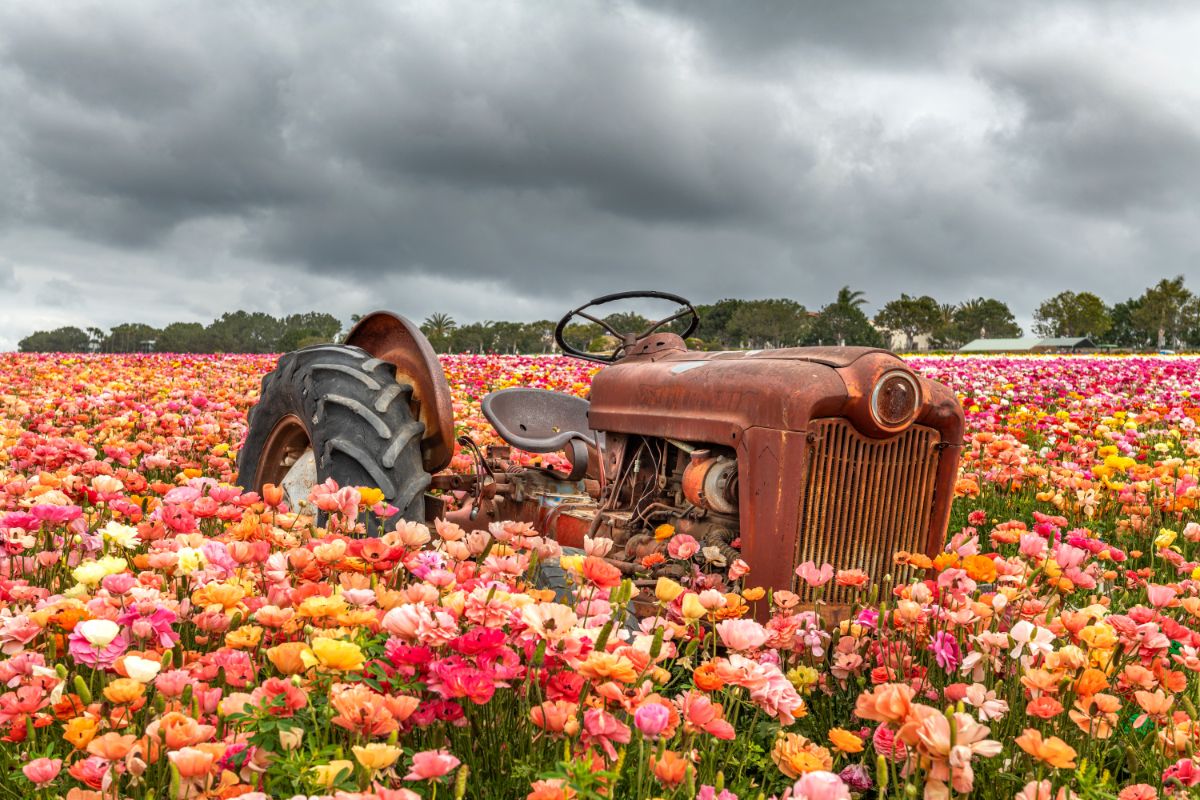
If you are excited to bring the beauty of ranunculus to your own garden, you will find the largest variety of buttercup cultivars by shopping online. Enjoy these showy blooms year after year!

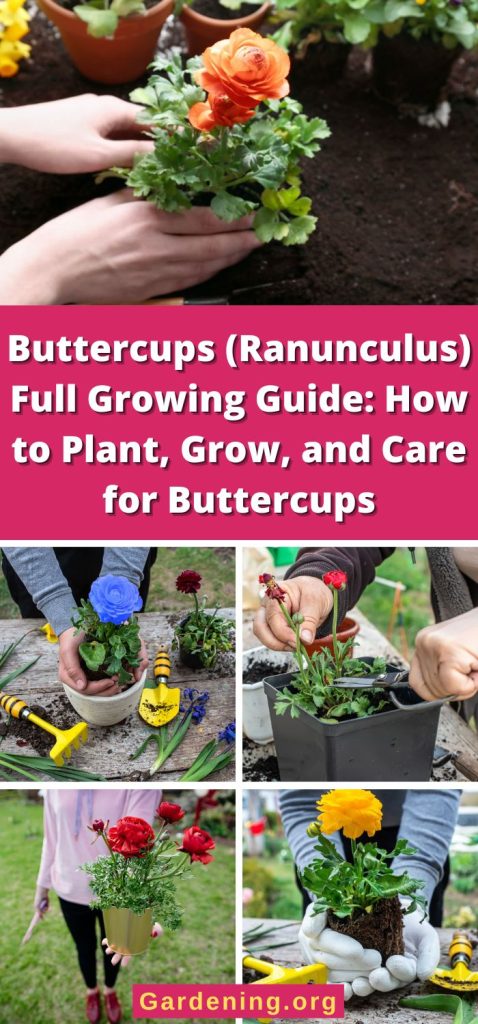
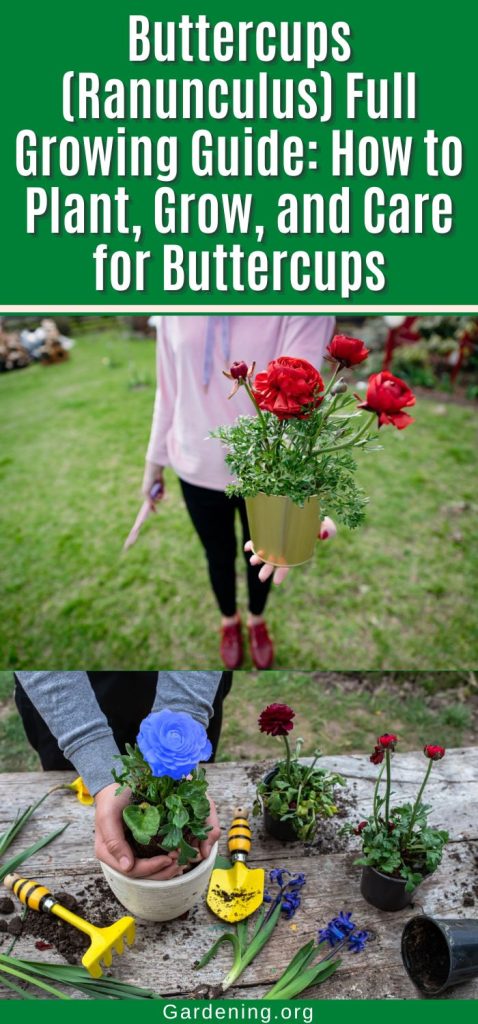
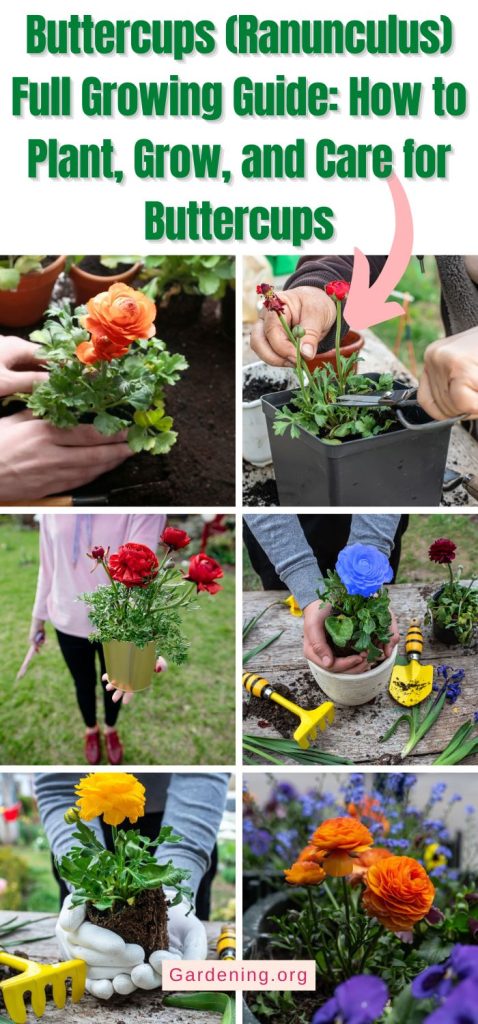
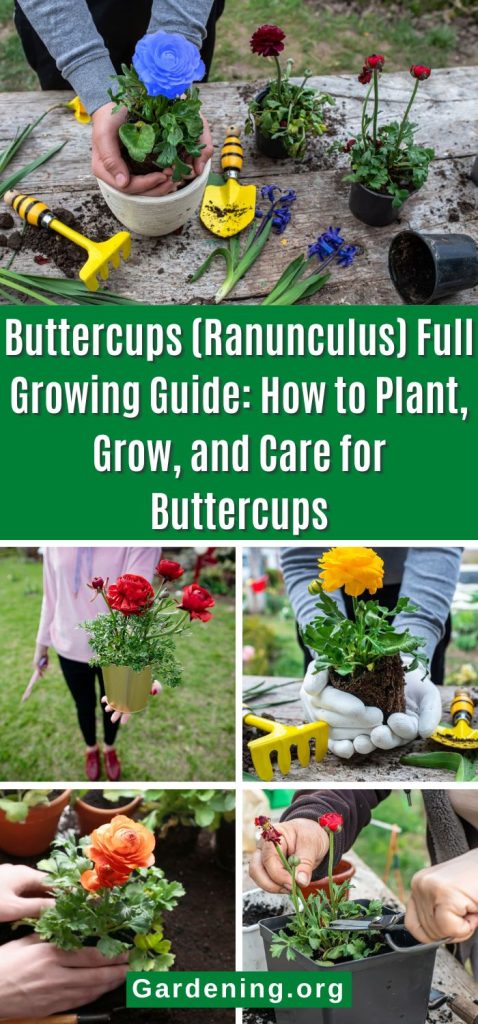
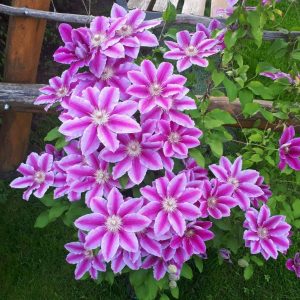
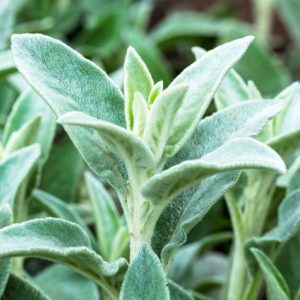

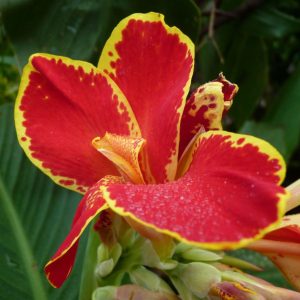
Leave a Reply